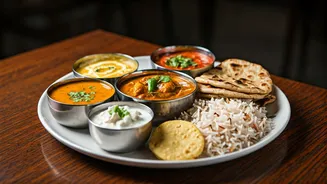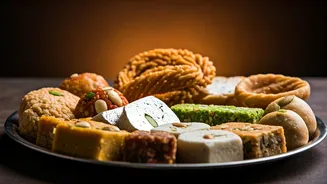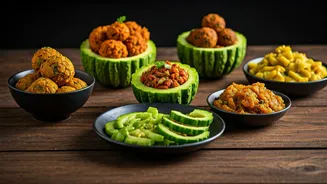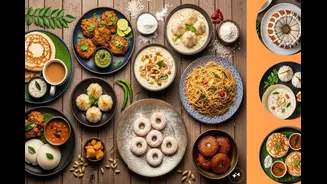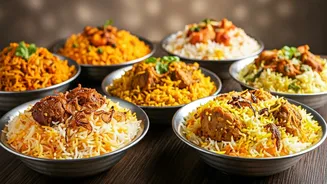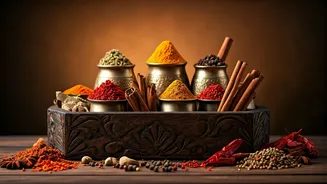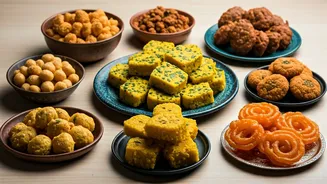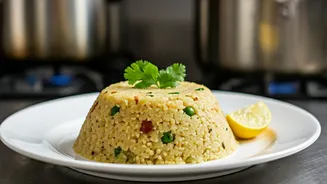A Culinary Journey Begins
India's vast landscape and varied cultures have given rise to a rich and complex food heritage. Each region boasts its own unique culinary style, characterized
by distinct ingredients, cooking techniques, and flavor profiles. From the fiery curries of the South to the rich gravies of the North, the food of India offers a symphony of tastes that reflects its diversity. This article celebrates the unique combinations that have evolved over generations, revealing the hidden gems beyond the familiar favorites. It encourages readers to explore beyond common dishes and embrace the regional specialties that make Indian cuisine so diverse. These combinations offer a delightful exploration of different textures, spices, and flavors, providing a journey of gastronomic discovery. The intent is to inspire readers to expand their culinary horizons and appreciate the intricate artistry that goes into creating these amazing dishes.
1. Litti Chokha: Bihar's Pride
Originating from the heart of Bihar, Litti Chokha stands as a testament to rustic simplicity and bold flavors. The litti, a ball of whole wheat flour, is stuffed with a savory mixture of sattu (roasted gram flour), spices, and herbs, then baked over a fire until it achieves a crispy exterior. The chokha, a smoky mash of roasted eggplant, tomatoes, and potatoes, adds a contrasting element of soft, tangy goodness. When eaten together, the combination of the crunchy litti and the flavorful chokha is a culinary explosion. Often served with a side of spicy green chutney and a dollop of ghee, Litti Chokha represents a complete and satisfying meal. The dish exemplifies the ingenuity of utilizing simple, locally sourced ingredients to create a memorable dining experience. The preparation methods, especially the open-fire baking, give it an undeniable smoky aroma that intensifies its flavor profile, making it a beloved dish.
2. Dhokla with chutney
Dhokla, a beloved Gujarati snack, is a light, fluffy, and steamed cake made from fermented batter of rice and chickpeas. Its soft, porous texture readily absorbs the flavors of accompanying ingredients. It is often seasoned with mustard seeds, green chilies, and coriander leaves. The chutney usually complements the dhokla's subtle flavors. While it varies from region to region, it is often a sweet and spicy tamarind chutney or a fresh green coriander chutney. These chutneys, with their contrasting characteristics, provide both a flavor and textural counterpoint to the soft dhokla. The balance of flavors makes this pairing a popular choice across the country. It is a harmonious marriage of textures and tastes, celebrated for its accessibility and taste.
3. Poha with Jalebi
Poha, a savory breakfast staple from Maharashtra, is made from flattened rice cooked with onions, potatoes, mustard seeds, and spices. It has a slightly tangy taste and a soft texture. The sweetness of the jalebi, a deep-fried, syrup-soaked dessert, complements the savory profile of the poha. The juxtaposition of textures is interesting, with the soft poha contrasting the crispness of the jalebi. This pairing creates a symphony of flavors in every bite, blending sweet and savory elements. This unique combination, enjoyed in many parts of India, underscores the country's approach to food, where contrasts are welcomed, and culinary boundaries are often transcended. It showcases how different flavors can co-exist harmoniously on a plate.
4. Appam with Stew
Appam, a pancake made from fermented rice batter, is a popular South Indian breakfast item. Its soft, lacy edges and slightly sour taste pair perfectly with the creamy vegetable or meat stew. Stews are made with coconut milk and often feature tender vegetables and meat, infused with aromatic spices. The subtle, fermented flavor of the appam absorbs the rich gravy of the stew. This pairing is a testament to the South Indian culinary approach, emphasizing the importance of fresh ingredients and well-balanced flavors. This combination offers a delightful texture contrast and an incredible blend of aromas. It represents a balanced meal, with the richness of the stew harmonizing with the subtle appam.
5. Baati with Churma
Originating from Rajasthan, Baati Churma is a dish that highlights the region's resourceful use of locally available ingredients. The baati, a hard, baked bread ball, is often dunked in ghee. The churma is a sweet crumble made from coarsely ground wheat, cooked with ghee and sugar, and sometimes flavored with cardamom and nuts. The dry, crumbly churma provides a contrasting texture to the hard baati. This dish is usually served together with Dal, and it offers a complete, balanced flavor profile. It is a hearty meal, perfect for the arid climate of Rajasthan. The Baati Churma reflects the region's focus on simple ingredients and unique culinary techniques.
6. Thukpa with Momos
Coming from the mountainous regions, Thukpa is a noodle soup with Tibetan origins, now popular throughout the Himalayas. It is made with thick wheat noodles, vegetables, and often meat, in a flavorful broth. Momos are steamed dumplings filled with meat or vegetables, seasoned with spices. Their savory fillings and tender casings contrast beautifully with the warm, comforting thukpa. The soup offers a light, broth-based meal, while the momos provide a substantial protein component. This combination offers a perfect balance of flavors and textures, with the warmth of the thukpa complementing the savory dumplings. It showcases the influence of Tibetan culture on Indian cuisine and is a great example of culinary adaptation.
